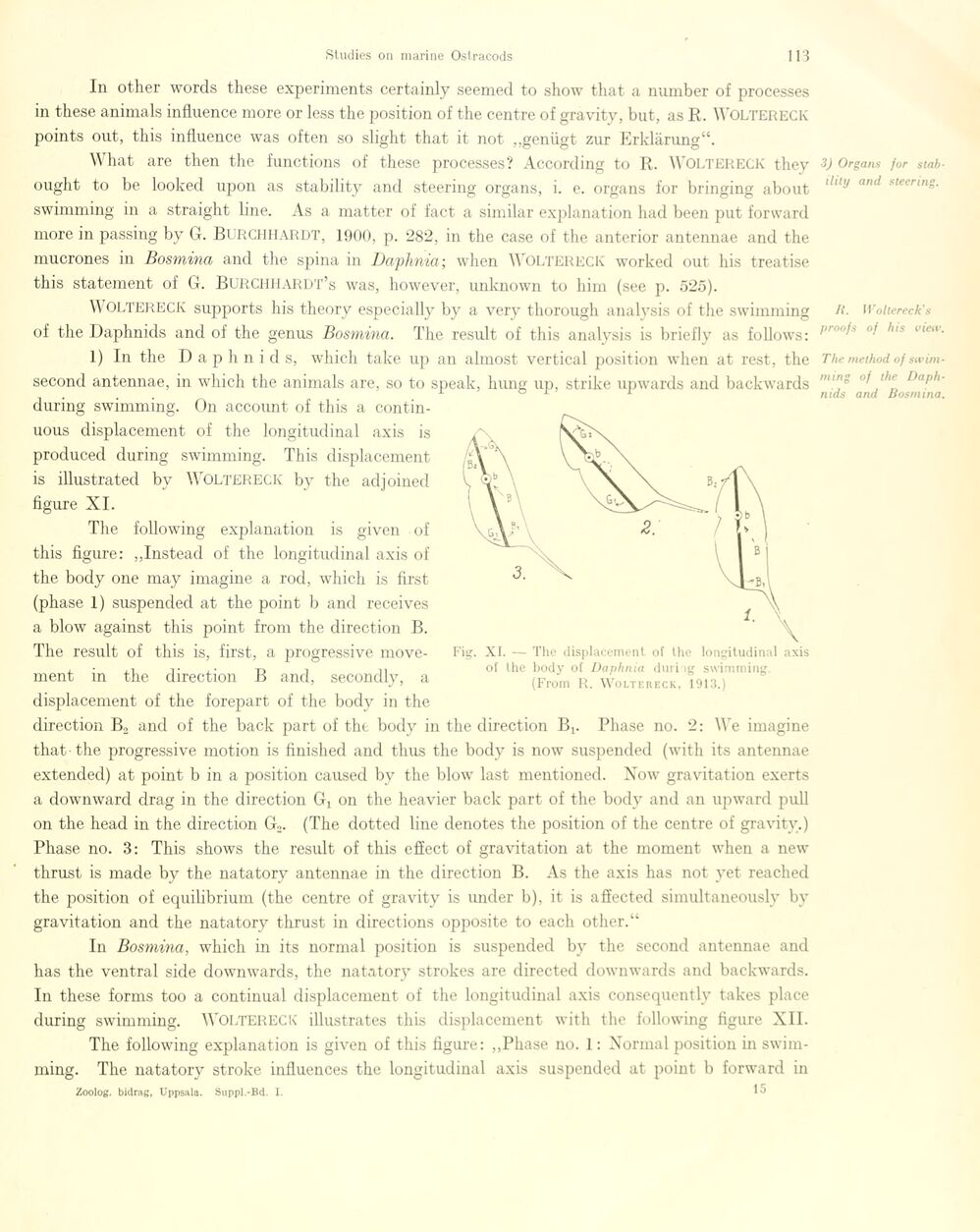
Full resolution (JPEG) - On this page / på denna sida - Sidor ...

<< prev. page << föreg. sida << >> nästa sida >> next page >>
Below is the raw OCR text
from the above scanned image.
Do you see an error? Proofread the page now!
Här nedan syns maskintolkade texten från faksimilbilden ovan.
Ser du något fel? Korrekturläs sidan nu!
This page has never been proofread. / Denna sida har aldrig korrekturlästs.
In other words these experiments certainlv seemed to show that a number of processes
in these animais influence more or less the position of the centre of gravity, but, as R. WOLTERECK
points out, this influence was often so slight that it not „genügt zur Erklärung“.
What are then the functions of these processes? According to R. WOLTERECK they
ought to be looked upon as stability and steering organs, i. e. organs for bringing about
swimming in a straight line. As a matter of fact a similar explanation had been put forward
more in passing by G. BURCHHARDT, 1900, p. 282, in the case of the anterior antennae and the
mucrones in Bosmina and the spina in Daphnia ; when WOLTERECK worked out his treatise
this statement of G. BURCHHARDT’s was, however, unknown to hirn (see p. 525).
WOLTERECK supports his theory especially by a very thorough analysis of the swimming
of the Daphnids and of the genus Bosmina. The result of this analysis is briefly as follows:
1) In the Daphnids, which take up an almost vertical position when at rest, the
second antennae, in which the animais are, so to speak, liung up, strike upwards and backwards
during swimming. On account of this a
continuons displacement of the longitudinal axis is
produced during swimming. This displacement
is illustrated by WOLTERECK by the adjoined
figure XI.
The following explanation is given of
this figure: „Instead of the longitudinal axis of
the body one may imagine a rod, which is first
(phase 1) suspended at the point b and receives
a blow against this point from the direction B.
The result of this is, first, a progressive
movement in the direction B and, secondly, a
displacement of the forepart of the body in the
direction B2 and of the back part of the body in the direction Bj. Phase no. 2: We imagine
that-the progressive motion is finished and thus the body is now suspended (with its antennae
extended) at point b in a position caused by the blow last mentioned. Now gravitation exerts
a downward drag in the direction Gt on the heavier back part of the body and an upward pull
on the head in the direction G2. (The dotted line denotes the position of the centre of gravity.)
Phase no. 3: This shows the result of this efîect of gravitation at the moment when a new
thrust is made by the natatory antennae in the direction B. As the axis has not yet reached
the position of equilibrium (the centre of gravity is nnder b), it is affected simultaneously by
gravitation and the natatory thrust in directions opposite to each other.“
In Bosmina, which in its normal position is suspended by the second antennae and
has the ventral side downwards, the natatory strokes are directed downwards and backwards.
In these forms too a continuai displacement of the longitudinal axis consequently takes place
during swimming. WOLTERECK illustrâtes this displacement with the following figure XII.
The following explanation is given of this figure: „Phase no. 1 : Normal position in
swimming. The natatory stroke influences the longitudinal axis suspended at point b forward in
Zoolog, bidrag, Uppsala. Suppl.-Bd. I. ^
Fig. XI. — The displacement of the longitudinal axis
of the body of Daphnia duii ig swimming.
(From R. Woltereck, 1913.)
3) Organs for
stability and stecring.
H. Woltereck’s
proojs of his vietv.
The melhod of
swimming of the
Daphnids and Bosmina.
<< prev. page << föreg. sida << >> nästa sida >> next page >>